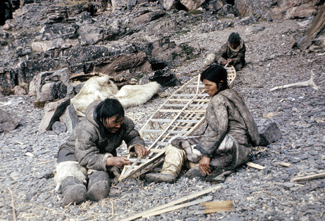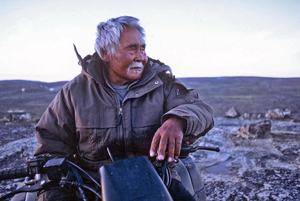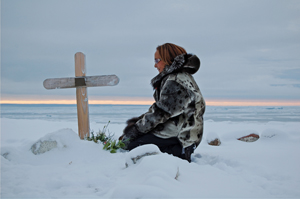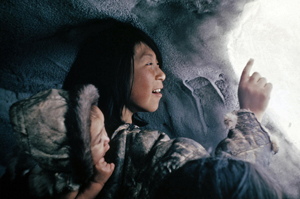Editorial: We’ve Moved!
Historic Ceremony in Kangiqsualujjuaq
Passages: Heiko Wittenborn
In the News
Point of View: Veterinary Service in Nunavik
Chinook Project: Summer 2011 Report
Unikkausivut: Sharing Our Stories
Making a Mitten Harness
Media Review: Martha of the North (video)
IMHO: Historical Perspective or Hyperbole
Index: Volume 13, The Fan Hitch
Navigating This Site
Index of articles by subject
Index of back issues by volume number
Search The Fan Hitch
Articles to download and print
Ordering Ken MacRury's Thesis
Our comprehensive list of resources
Defining the Inuit Dog
Talk to The Fan Hitch
The Fan Hitch home page
ISDI home page
Editor's/Publisher's Statement
Editor: Sue Hamilton
Webmaster: Mark Hamilton
The Fan Hitch, Journal of
the Inuit Sled Dog, is published four times
a year. It is available at no cost online
at: https://thefanhitch.org.
The Fan Hitch welcomes your letters, stories, comments and suggestions. The editorial staff reserves the right to edit submissions used for publication.
Contents of The Fan Hitch are protected by international copyright laws. No photo, drawing or text may be reproduced in any form without written consent. Webmasters please note: written consent is necessary before linking this site to yours! Please forward requests to Sue Hamilton, 55 Town Line Rd., Harwinton, Connecticut 06791, USA or mail@thefanhitch.org.
This site is dedicated to the Inuit Dog as well as related Inuit culture and traditions. It is also home to The Fan Hitch, Journal of the Inuit Sled Dog.
The Fan Hitch welcomes your letters, stories, comments and suggestions. The editorial staff reserves the right to edit submissions used for publication.
Contents of The Fan Hitch are protected by international copyright laws. No photo, drawing or text may be reproduced in any form without written consent. Webmasters please note: written consent is necessary before linking this site to yours! Please forward requests to Sue Hamilton, 55 Town Line Rd., Harwinton, Connecticut 06791, USA or mail@thefanhitch.org.
This site is dedicated to the Inuit Dog as well as related Inuit culture and traditions. It is also home to The Fan Hitch, Journal of the Inuit Sled Dog.

Building a qajaq; from The Netsilik Eskimo Today directed by
Gilles Blais, produced by John Friedman and François Séguillon
© 1972 National Film board of Canada. All rights reserved.
Unikkausivut – Sharing Our Stories
This telephone interview took place on Tuesday, August 9, 2011, between
Claude Joli-Coeur, Assistant Commissioner, National Film Board of Canada
and Sue Hamilton of The Fan Hitch
CJ-C: Hello, Sue.
SH: Good morning, Claude! Thank you so much for your time. I am so excited!
CJ-C: It's a pleasure.
SH: Well, where do we start?
CJ-C: I'm quite excited about the Unikkausivut – Sharing Our Stories project, because it's very special to what we're doing, and it is so important for the Inuit people, that we've been devoting special attention to the project. The NFB was established more than 70 years ago and for those 70 years we have been producing films about the Inuit, with the Inuit and by the Inuit. And I think we have one of the most precious collections of films, the biggest collection in the world, about their culture. It's been created over the years and we felt we had an obligation to make it available to the Inuit people and also to the rest of our country, so that all Canadians understand the richness of that culture, its traditions and understand also the uniqueness of the Inuit, who represent 50,000 people across the country. It's a very tiny population spread over a huge land space but they are Canadians like us, and they deserve a special place in our society.
SH: The timing is very significant, with all the results of the truth commissions coming out now.
CJ-C: That's right.
SH: Your project will help southern Canadians understand what that is all about because I don't think they all fully grasp the issues.
CJ-C: Absolutely. And people are very often confusing the Inuit, the First Nations and the Metis. The Inuit have a special place in the Canadian Constitution as a distinct group. Their status as Inuit makes them a unique part of this country—they are the indigenous people of the Arctic. That's key for us. Because we at the NFB as a public institution, we want other citizens of the world to understand the richness of Canada and of the Inuit culture and its traditions. So we have a plan to make the Unikkausivut films available to our international distribution network.
SH: You know, our goals are similar. I've always believed that you can't understand or appreciate the Inuit Dog without understanding Inuit culture. And this is why I am so excited about what you are doing.
CJ-C: I presume you have visited the North often. But I was shocked when I was there to see how the dog had been just put aside, and the youngest people were losing that connection and that tradition, and we hope that they will be able to re-appropriate that tradition.

Naalak Nappaaluk; from If the Weather Permits; directed
by Eisapie Isaac, produced by Yves Bisaillon
Photo: Alex Margineau; © 1972 National Film board of Canada.
All rights reserved.
CJ-C: Our project, as you may have read, will be available in two formats. We are producing a DVD box set that will have twenty-four of our films that will be distributed in basically every Inuit community through the local leaders and we will also have a website platform with films available for viewing. The website will be enriched over the next five years to include all 110 films, and more, so there is a lot of work to be done. We're translating all the films into Inuktitut. We're going to make sure that there is an Inuktitut version available, and the films need to be digitized, rights need to be cleared. It's a major undertaking.
SH: When you will start building the website? Are you doing it in advance or only when the 110 films are ready to mount?
CJ-C: We are doing it at the same time. We're launching the Unikkausivut DVD box set this November. On November 2nd, 2011, the 40th anniversary of the Inuit Tapiriit Kanatami [ITK], there is a series of events happening in Ottawa, so the DVD box set official launch will be there in Ottawa during a special evening, which will be followed by a week of personal visits with representatives of the NFB in some major communities of the four Inuit regions. We will host events in those communities and we'll make sure that they all receive the DVD box set copies needed.
With the website, the difficulty is of course the limitations that they have in the North with bandwidth. We are working in partnership with the Nunavut Government Education Department, who are re-doing their curriculum, which will include a selection of films from Unikkausivut. So on local servers the films will be available to schools and so forth. But in order to overcome the bandwidth limitation we'll make sure that, as much as possible, we'll make available on local servers only those films that are not a part of the DVD box set.

Martha Flaherty from Martha of the North; directed by
Marquise Lepage, produced by Johanne Bergeron (ONF),
Yves Bisallon (ONF), Marcel Simard (VIRAGE)
Photo: Évangéline DePas; © 2009 Productions Virage
CJ-C: We're trying to. And you know what? One thing that has been key in our process has been working with the Inuit. From the very beginning when we started the Unikkausivut project more than a year ago with the Inuit Relations Secretariat (Aboriginal Affairs and Northern Development Dept.), we took the attitude that we don't want the approach to be by white people for the Inuit, instead we want this project to be of and with the Inuit. So we have created an advisory committee and we have six members on this committee coming from every region of Canada, the four regions plus someone from ITK and someone from Pauktuutit Inuit Women's Association. So they have been key to guiding us in the needs of their communities, in what we should do and in terms of choosing the appropriate dialect for the films, which is very challenging.
SH: Yes it is, because it can be extraordinarily difficult to do translations where there are no Inuktitut words for some English words.
CJ-C: That's right! And the approach that we have taken for the DVD box set and also for the other films is that we will use the dialect of the region where the films were shot. And all the films will be spoken in Inuktitut with French and English subtitles. For that we also have Inuit advisors working with us. So it's very collaborative work.
SH: You know that there are many polar institutions all over the world and perhaps they would be willing to contribute to help this along.
CJ-C: Our plan is to approach them to make sure we have the widest distribution possible, for sure. We've been in contact with some of them and of course so far we've really been focusing on the production of the various versions and to meet our November 2nd deadline. But that doesn't mean we won't continue our outreach to contact them.
I don't know if you've heard that our Unikkausivut initiative is one of the Canadian projects to be represented during the 2011 inter-American Year of culture of the Organization of American States (Canada, United States, Mexico and countries from South America). And in terms of being known across the Americas, there is a lot of interest from different countries dealing with their aboriginal communities, so that's another angle we're pursuing.
SH: I am so grateful for the opportunity to share this information in The Fan Hitch. We know that people are coming to our site from all over the world.
CJ-C: Interesting. It will be great that people will be able to connect. And of course we will keep you informed of all the developments.

From The Netsilik Eskimo Today directed by Gilles Blais,
produced by John Friedman and François Séguillon
© 1972 National Film board of Canada. All rights reserved.
CJ-C: But on the website there will already be films available which will be launched at the same time this November, and which will be enriched over the months with new material. It's coming up very soon now!
Getting back to that summit, in Colombia there will be a summit for the Americas for the pan-American organization next April, so that is where we are planning to showcase Unikkausivut.
SH: Will the collection be available to purchase or just be available to watch online?
CJ-C: Online it will be available and anybody will be able to watch it. But you will also be able to buy the DVD box set and some of the films will also be available to download-to-own individually. So it will be a mixture of free streaming, buying the DVD box set or downloading a film to your computer or mobile device.
SH: Will this collection be the only way for non-Aboriginals to learn about Inuit culture? The reason I ask this is that I have seen some of the videos that are filmed by white people, and the dialogue and perspective isn't exactly an Inuit perspective.
CJ-C: That is a part of the richness of our collection, to see the evolution of how Inuit culture was represented. We have films that were originally made by white people, with a European approach. And later, we see white people who have transformed themselves through the cause of the Inuit, becoming almost Inuit themselves. We are now making films with Inuit creators. And we have selected the films to give you that historical perspective. That is something that we will explain also in terms of the social context. The films have been chosen by our Inuit advisory committee to make sure they represent this evolution well. We know that some of the films are very paternalistic and that they have an approach which would not be appropriate now, but they are also part of the history and we wanted to have that wide perspective, which gives Unikkausivut its ethnographic value. So it has been done on purpose. We have our collection analysts here who also understand that evolution very well. That explanation is something we will make available in our material which accompanies the films, to give a perspective on why they were done that way. So there is a historical approach to it.
SH: It sounds very well thought out and culturally sensitive. Thank you so much for what you are doing. I firmly believe that everybody has something to contribute to the future of the Inuit Dog in many different ways. And to me your way is important in that you are recording the Inuit past and making it available to people as a hope for the future of the Inuit Dog.
CJ-C: Thank you for this conversation and your interest. I'm very glad that we will be connected.
SH: I am happy to share your project with the world, and maybe there are organizations that would like to make donations to your project.
CJ-C: Great. Thank you so much. We will keep in touch.